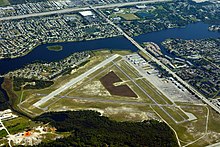Relief airport: Difference between revisions
Deauthorized (talk | contribs) m Reverted edits by 208.184.136.2 (talk): unexplained content removal (HG) (3.4.10) |
Theblindsage (talk | contribs) General rewrite/expansion of the stub. |
||
| Line 1: | Line 1: | ||
[[File:Palm Beach County Park Lantana Airport photo D Ramey Logan.jpg|thumb|[[Palm Beach County Park Airport]] ]] |
[[File:Palm Beach County Park Lantana Airport photo D Ramey Logan.jpg|thumb|[[Palm Beach County Park Airport]] ]] |
||
A '''relief airport''' or '''reliever airport''' is an [[airport]] that is built or designated to provide relief or additional capacity to an area when the primary [[commercial airport|commercial airport(s)]] |
A '''relief airport''' or '''reliever airport''' is an [[airport]] that is built or designated to provide relief or additional capacity to an area when the primary [[commercial airport|commercial airport(s)]] requires additional capacity, on a long-term or temporary basis. Reliever airports may also relieve the need for capacity by relocating non-jet [[General Aviation]] activity from a commercial airport to a different facility. By removing aircraft with lower capacities and slower speeds, the commercial service airport is able to operate more flights with larger aircraft and handle more passengers increasing efficiency with minimal additional cost in facilities. This also spreads out the aircraft over a wider area generally improving [[air traffic]] in the entire community. |
||
To qualify |
To qualify as a FAA-designated reliever, an airport must have 100 or more based aircraft or 25,000 annual itinerant operations.<ref>{{citation |url=https://www.faa.gov/airports/planning_capacity/npias/reports/historical/media/2009/npias_2009_narrative.pdf |title=National Plan of Integrated Airport Systems (NPIAS): 2009–2013 |publisher=Federal Aviation Administration |page=8 |access-date=2017-03-31}}</ref> |
||
==See also== |
==See also== |
||
* [[Executive airport]], a marketing term employed to promote general aviation to corporate jet |
* [[Executive airport]], a marketing term employed to promote general aviation to corporate jet travelers |
||
* [[FAA airport categories]] |
* [[FAA airport categories]] |
||
* [[List of cities with more than one commercial airport]] |
* [[List of cities with more than one commercial airport]] |
||
Revision as of 19:07, 20 June 2021

A relief airport or reliever airport is an airport that is built or designated to provide relief or additional capacity to an area when the primary commercial airport(s) requires additional capacity, on a long-term or temporary basis. Reliever airports may also relieve the need for capacity by relocating non-jet General Aviation activity from a commercial airport to a different facility. By removing aircraft with lower capacities and slower speeds, the commercial service airport is able to operate more flights with larger aircraft and handle more passengers increasing efficiency with minimal additional cost in facilities. This also spreads out the aircraft over a wider area generally improving air traffic in the entire community.
To qualify as a FAA-designated reliever, an airport must have 100 or more based aircraft or 25,000 annual itinerant operations.[1]
See also
- Executive airport, a marketing term employed to promote general aviation to corporate jet travelers
- FAA airport categories
- List of cities with more than one commercial airport
References
- ^ National Plan of Integrated Airport Systems (NPIAS): 2009–2013 (PDF), Federal Aviation Administration, p. 8, retrieved 2017-03-31
- The Impact of a General Aviation Airport on Surrounding Land Use Patterns: Richard Lloyd Jones Jr. Airport Brockway, David Arthur. ProQuest. 2007.
